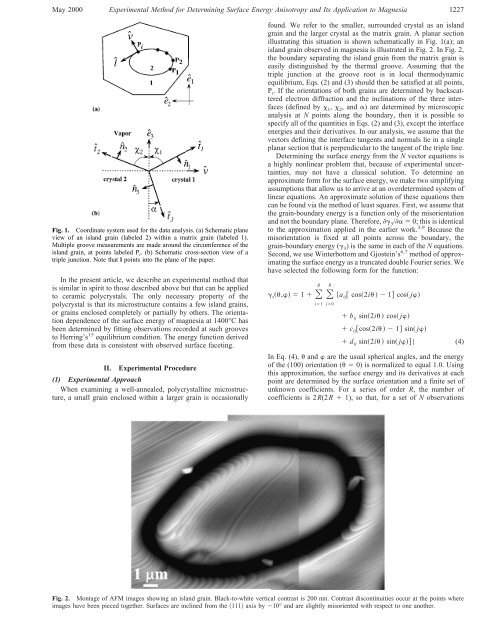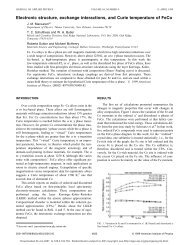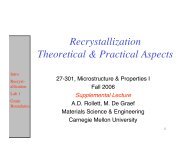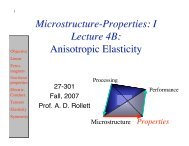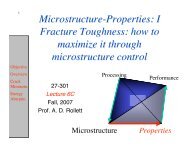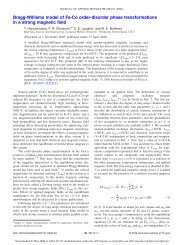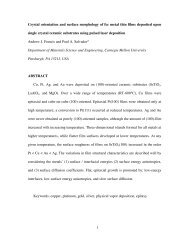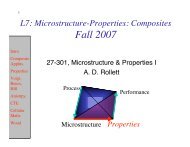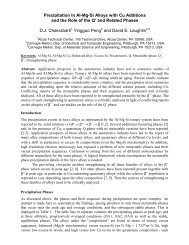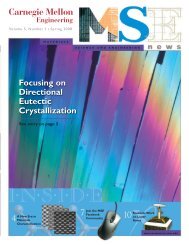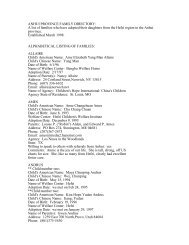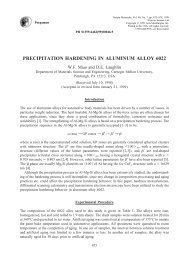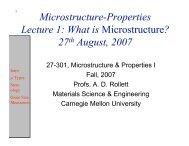Experimental Method for Determining Surface Energy - Materials ...
Experimental Method for Determining Surface Energy - Materials ...
Experimental Method for Determining Surface Energy - Materials ...
You also want an ePaper? Increase the reach of your titles
YUMPU automatically turns print PDFs into web optimized ePapers that Google loves.
May 2000 <strong>Experimental</strong> <strong>Method</strong> <strong>for</strong> <strong>Determining</strong> <strong>Surface</strong> <strong>Energy</strong> Anisotropy and Its Application to Magnesia 1227<br />
Fig. 1. Coordinate system used <strong>for</strong> the data analysis. (a) Schematic plane<br />
view of an island grain (labeled 2) within a matrix grain (labeled 1).<br />
Multiple groove measurements are made around the circumference of the<br />
island grain, at points labeled P i. (b) Schematic cross-section view of a<br />
triple junction. Note that l points into the plane of the paper.<br />
In the present article, we describe an experimental method that<br />
is similar in spirit to those described above but that can be applied<br />
to ceramic polycrystals. The only necessary property of the<br />
polycrystal is that its microstructure contains a few island grains,<br />
or grains enclosed completely or partially by others. The orientation<br />
dependence of the surface energy of magnesia at 1400°C has<br />
been determined by fitting observations recorded at such grooves<br />
to Herring’s 15 equilibrium condition. The energy function derived<br />
from these data is consistent with observed surface faceting.<br />
II. <strong>Experimental</strong> Procedure<br />
(1) <strong>Experimental</strong> Approach<br />
When examining a well-annealed, polycrystalline microstructure,<br />
a small grain enclosed within a larger grain is occasionally<br />
found. We refer to the smaller, surrounded crystal as an island<br />
grain and the larger crystal as the matrix grain. A planar section<br />
illustrating this situation is shown schematically in Fig. 1(a); an<br />
island grain observed in magnesia is illustrated in Fig. 2. In Fig. 2,<br />
the boundary separating the island grain from the matrix grain is<br />
easily distinguished by the thermal groove. Assuming that the<br />
triple junction at the groove root is in local thermodynamic<br />
equilibrium, Eqs. (2) and (3) should then be satisfied at all points,<br />
P i. If the orientations of both grains are determined by backscattered<br />
electron diffraction and the inclinations of the three interfaces<br />
(defined by 1, 2, and ) are determined by microscopic<br />
analysis at N points along the boundary, then it is possible to<br />
specify all of the quantities in Eqs. (2) and (3), except the interface<br />
energies and their derivatives. In our analysis, we assume that the<br />
vectors defining the interface tangents and normals lie in a single<br />
planar section that is perpendicular to the tangent of the triple line.<br />
<strong>Determining</strong> the surface energy from the N vector equations is<br />
a highly nonlinear problem that, because of experimental uncertainties,<br />
may not have a classical solution. To determine an<br />
approximate <strong>for</strong>m <strong>for</strong> the surface energy, we make two simplifying<br />
assumptions that allow us to arrive at an overdetermined system of<br />
linear equations. An approximate solution of these equations then<br />
can be found via the method of least squares. First, we assume that<br />
the grain-boundary energy is a function only of the misorientation<br />
and not the boundary plane. There<strong>for</strong>e, 3/ 0; this is identical<br />
to the approximation applied in the earlier work. 3,9 Because the<br />
misorientation is fixed at all points across the boundary, the<br />
grain-boundary energy ( 3) is the same in each of the N equations.<br />
Second, we use Winterbottom and Gjostein’s 6,7 method of approximating<br />
the surface energy as a truncated double Fourier series. We<br />
have selected the following <strong>for</strong>m <strong>for</strong> the function:<br />
R<br />
s, 1 <br />
i1<br />
R<br />
aij cos2i 1 cos j<br />
j0<br />
bij sin2i cos j<br />
cijcos2i 1 sin j<br />
dij sin2i sin j} (4)<br />
In Eq. (4), and are the usual spherical angles, and the energy<br />
of the (100) orientation ( 0) is normalized to equal 1.0. Using<br />
this approximation, the surface energy and its derivatives at each<br />
point are determined by the surface orientation and a finite set of<br />
unknown coefficients. For a series of order R, the number of<br />
coefficients is 2R(2R 1), so that, <strong>for</strong> a set of N observations<br />
Fig. 2. Montage of AFM images showing an island grain. Black-to-white vertical contrast is 200 nm. Contrast discontinuities occur at the points where<br />
images have been pieced together. <strong>Surface</strong>s are inclined from the 111 axis by 10° and are slightly misoriented with respect to one another.


